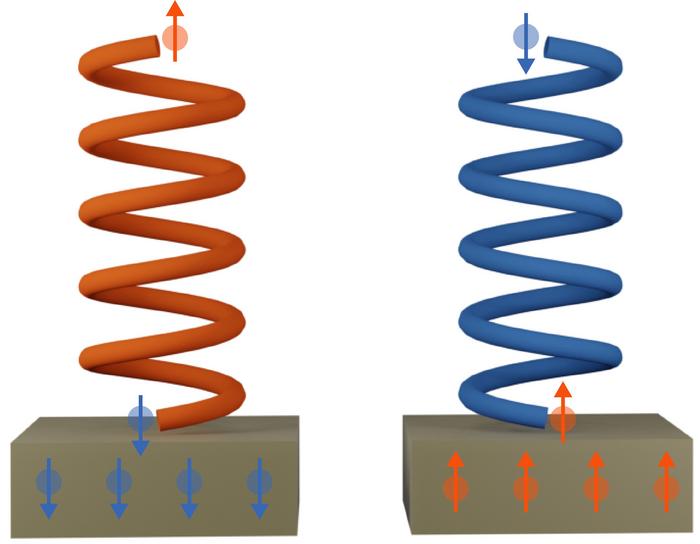The intriguing world of electrons has long captivated physicists, particularly their role in electric currents and their intrinsic properties like spin and magnetic moment. Traditionally, the manipulation of these intrinsic characteristics has proven arduous, especially when it comes to accessing specific spins. One method to achieve this is by passing an electric current through ferromagnetic materials, for instance, iron, which can yield a current aligned with an external magnetic field. This phenomenon has provided fertile ground for advances in the field of spintronics, where the focus is not merely on the charge of electrons but also on their spins.
The exploration of alternative methods for spin selection has intensified over the past decade, with one promising avenue being the use of chiral molecules—those that cannot be superimposed onto their mirror images. Helices, which are common structures in these molecules, have shown remarkable potential. Research has indicated the capability of inducing a spin polarization of around 60 to 70 percent in currents passing through chiral molecules, a level comparable to that achieved with conventional ferromagnetic materials. Nevertheless, the intricacies involved in this process have kept it mired in scientific discussion and ongoing investigation.
In pure gold films, a mere three percent of the spin current is typically transformed into a charge current, unaffected by the orientation of electron spins. However, the introduction of chiral molecules on the surface of this gold film transforms the dynamics drastically. When right-handed molecules are present, electrons with spin-up transition to charge current much more effectively than their spin-down counterparts. This interaction is reversed with left-handed chiral molecules, demonstrating that chirality plays a crucial role in the conversion efficiency of spin to charge.
The implications of these advancements extend beyond the realm of theoretical research; they tap into potential applications in future technology. The ability to selectively convert spin currents to charge currents, depending on molecular chirality, may facilitate the development of more efficient data storage devices and other technological advancements. These findings signify a step forward in understanding the fundamental interactions between spin and charge, emphasizing the pivotal role of molecular structure in such processes.
This investigation into the CISS effect also reveals an inherent vectorial characteristic. The efficiency of spin-to-charge conversion is contingent upon the alignment between the spin direction and the helix orientation of the chiral molecule. When aligned, this phenomenon occurs optimally, while misalignment negates the effect. Thus, the study not only underscores a key principle in spintronics but also opens avenues for designing devices that exploit these chiral interactions for practical applications.
The promise of this research lies in its capacity to bridge gaps between theoretical and practical realms in spintronics. By shedding light on the fundamental interplay between electron spin and chiral structures, scientists are approaching a deeper comprehension of how to harness these properties in innovative ways. The work conducted by Professor Wittmann’s team at the JGU serves as a cornerstone for future explorations and technological implementations, highlighting the significance of chiral molecules in spin phenomena.
As this field evolves, it holds the potential to redefine our understanding of electronics and data storage, ultimately leading to faster, more efficient devices. Spintronics, powered by chirality, could lead to a technological renaissance where electronic devices become increasingly sophisticated, energy-efficient, and compact. The quest for efficient spin selectivity may well be the key to unlocking new frontiers in material science and engineering innovations.
In conclusion, the groundbreaking research at Johannes Gutenberg University Mainz establishes a crucial contribution to the ongoing discourse surrounding spin selectivity and chiral molecular effects. As the scientific community continues to investigate and exploit these findings, we may very well be on the cusp of a significant leap forward in the abilities of electronic devices.
Subject of Research: Chiral-induced spin selectivity in hybrid systems
Article Title: Chiral-induced unidirectional spin-to-charge conversion
News Publication Date: 1-Jan-2025
Web References: Science Advances DOI
References: Not provided
Image Credits: Angela Wittmann
Keywords
Spintronics, chiral molecules, spin selectivity, electron spin, data storage, hybrid systems, charge current, chirality, gold thin films, unidirectional conversion, magnetic moment, quantum mechanics.
Tags: advances in spintronic technologychiral molecules in spintronicscurrent-induced spin polarizationelectric current and electron propertieselectron spin manipulationferromagnetic materials and spinhelices in molecular structuresmagnetic properties of electronsresearch on spintronics and chiral moleculesrole of chiral molecules in physicsspin polarization in chiral moleculesspintronics





